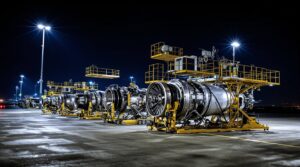One of the key aspects of airworthiness determination is the certification process. Aircraft manufacturers must adhere to stringent standards during the design and production phases. The Federal Aviation Administration (FAA) in the United States, for example, is a prominent authority that oversees the certification process. The FAA ensures that an aircraft meets the necessary safety and performance criteria before it is deemed airworthy.
In addition to regulatory bodies, airlines also play a crucial role in maintaining airworthiness. They are responsible for the ongoing airworthiness management of their fleets. This includes regular maintenance, inspections, and compliance with manufacturer-recommended procedures. Airlines must have a dedicated airworthiness department to monitor and address any issues that may arise during the operational life of an aircraft.
Moreover, individual aircraft owners also carry a share of the responsibility for determining airworthiness. Whether it’s a private individual owning a small aircraft or a corporation managing a fleet, they must adhere to the prescribed maintenance schedules and regulatory requirements. The owner/operator is accountable for ensuring that the aircraft remains airworthy throughout its service life.
The role of maintenance personnel in airworthiness determination is paramount. Licensed aircraft maintenance engineers (LAMEs) or mechanics are entrusted with the hands-on tasks of inspecting, repairing, and certifying the aircraft. Their expertise ensures that every component meets the required standards, contributing to the overall airworthiness of the aircraft.
Furthermore, the concept of airworthiness involves continuous monitoring and assessment. The aviation industry employs a robust surveillance system that includes mandatory reporting of incidents and accidents. This information is analyzed by authorities to identify trends or potential issues that may affect the airworthiness of certain aircraft types.
Aviation safety authorities responsible for issuing airworthiness certificates play a crucial role in ensuring the safety and reliability of aircraft. These certificates, commonly known as the golden ticket for aircraft, signify that an aircraft meets the necessary safety standards set by regulatory bodies.
One of the primary entities involved in this process is the Federal Aviation Administration (FAA). As the main aviation regulatory body in the United States, the FAA is responsible for issuing airworthiness certificates for both civil aircraft and their components. The FAA ensures that the aircraft design, construction, and maintenance comply with the established regulations and standards.
Internationally, the European Union Aviation Safety Agency (EASA) plays a key role in the certification process. EASA issues airworthiness certificates for aircraft operating in the European Union and works closely with national aviation authorities to maintain a harmonized and high level of safety standards across member states.
Other notable authorities include the Civil Aviation Authority (CAA) in various countries, each responsible for regulating aviation safety within its jurisdiction. The CAA ensures that aircraft registered within its territory adhere to safety standards and are fit for operation.
The process of obtaining an airworthiness certificate involves a thorough examination of the aircraft’s design, manufacturing, and maintenance documentation. This examination is conducted by a team of certification engineers who meticulously review every aspect to ensure compliance with safety regulations.
Airworthiness directives issued by these authorities are crucial for maintaining the safety of existing aircraft. These directives may require modifications or inspections to address safety concerns identified during the aircraft’s operational life.
Collaboration between aviation authorities is paramount to ensure a global standard for aviation safety. International Civil Aviation Organization (ICAO) sets global standards and recommended practices, guiding the efforts of aviation authorities worldwide. The cooperation between these entities contributes to the overall safety of air travel.
Aircraft manufacturers obliged to prove airworthiness before delivery
Ensuring the airworthiness of aircraft is a critical process that aircraft manufacturers must meticulously undertake before delivering their creations to the skies. The journey begins with a series of rigorous stress tests, where the aircraft’s components are subjected to extreme conditions to evaluate their structural resilience. These tests, often conducted in specialized facilities, simulate the harshest conditions the aircraft might encounter during its operational life.
The backbone of this validation process lies in subjecting the aircraft to simulated forces that mirror the forces it would experience in flight. Stress tests are not just routine check-ups; they are intense examinations that push the aircraft to its limits, ensuring it can withstand the dynamic and unpredictable nature of real-world flight scenarios.
One of the crucial steps in validating an aircraft’s design is the use of a wind tunnel. This innovative apparatus allows engineers to assess the aerodynamic performance of the aircraft in a controlled environment. Picture a massive tube with air rushing through it—this is where the magic happens. The wind tunnel enables engineers to observe how the aircraft responds to different wind conditions, providing valuable insights into its stability, lift, and overall flight characteristics.
Imagine a ballet of forces, where the aircraft dances with the wind, revealing its strengths and vulnerabilities. The wind tunnel not only refines the aerodynamic design but also unveils potential issues that might arise during actual flight, allowing engineers to fine-tune the aircraft’s configuration for optimal performance and safety.
Once the aircraft has gracefully navigated the wind tunnel, it’s time for the creation of the physical manifestation of the design—the prototype. This isn’t just a model; it’s a fully functional aircraft that serves as the tangible result of countless hours of design, analysis, and testing. The prototype is the embodiment of the manufacturer’s vision, a tangible proof of concept that brings the theoretical into the tangible.
However, the prototype is not just a showpiece. It undergoes its own set of stress tests, ensuring that the intricacies of the design translate seamlessly into a flying machine capable of withstanding the demands of the skies. This phase is the final frontier before mass production, where every element of the prototype is scrutinized to guarantee that the design is not only elegant but robust and reliable.
In essence, the process of proving airworthiness is an intricate ballet between stress tests, the precision of the wind tunnel, and the culmination in the tangible prototype. It’s a symphony of engineering brilliance and creativity, where each note is a validation that the aircraft is not just a machine but a masterpiece ready to soar.
Pilots required to perform pre-flight checks every time
Performing pre-flight checks is an indispensable ritual for pilots, akin to a meticulous prelude before embarking on a grand journey through the skies. These checks are not merely bureaucratic hoops but rather a symphony of safety measures harmonizing to ensure a secure and controlled flight experience.
At the heart of this prelude is the revered checklist, a sacred scripture for pilots. This checklist is no ordinary list; it is a comprehensive compendium of tasks and verifications, meticulously curated to leave no room for oversight. Pilots, the custodians of the airborne realm, are required to follow this ritual without fail.
The checklist, a dynamic guide, dances between the realms of mundane and critical tasks. It choreographs a sequence of actions that transcend the routine, breathing life into the mechanical intricacies of the aircraft. Pilots, armed with this document, embark on a pilgrimage of sorts, ensuring that every switch, lever, and dial aligns with the prescribed symphony.
As the checklist unfolds, the pilot’s journey dives into the realm of visual inspection. Akin to a hawk assessing its prey before the descent, pilots engage in a visual ballet around the aircraft. With acute precision, they scan the surface for any blemish, imperfection, or irregularity that may disrupt the harmony of flight.
The visual inspection is more than a mere glance; it is an intimate communion between the pilot and the aircraft. Each rivet, each seam, and every inch of the fuselage is scrutinized. The aircraft, in return, whispers its state of being, revealing subtle nuances that escape the untrained eye.
Amidst this visual ballet, the pilot’s hands caress the flight controls, the very appendages that translate intention into motion. The flight controls, the nerve endings of aviation, are subject to an intricate tactile dialogue. The pilot, with a discerning touch, tests the ailerons, elevators, and rudders, ensuring they respond with the grace of a seasoned dance partner.
The flight controls are not mere mechanical components; they are extensions of the pilot’s will. The pre-flight ritual, encapsulated in the checklist and visual inspection, converges in this moment of communion with the flight controls. It is here that the pilot becomes one with the aircraft, forging a pact that extends beyond the tangible into the ethereal realm of flight.






